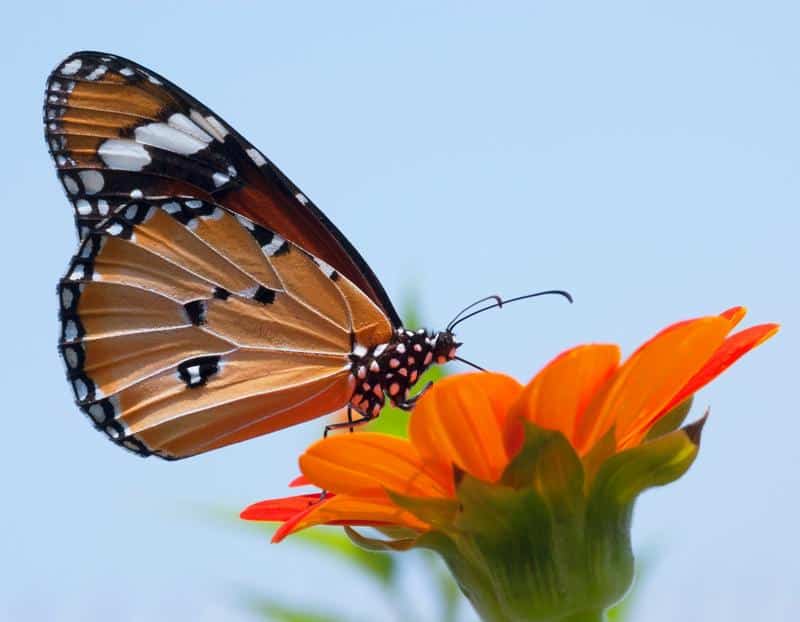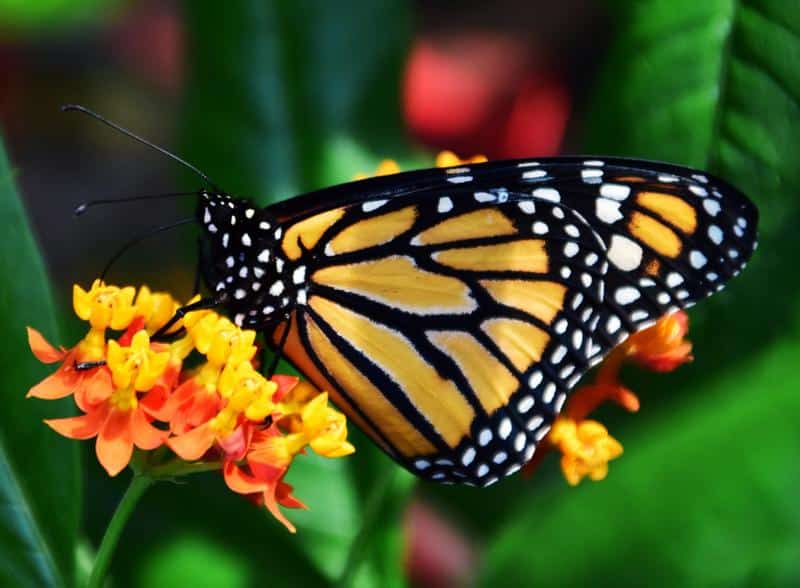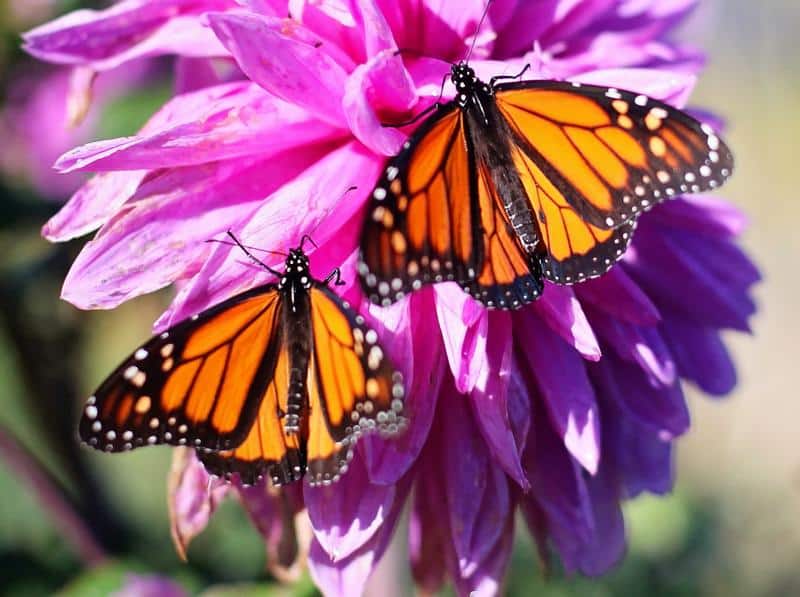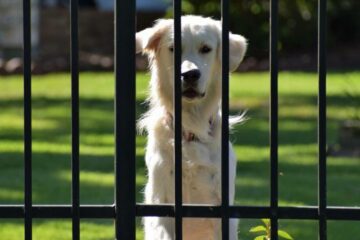Are Monarch Butterflies Poisonous to Dogs?
Are monarch butterflies poisonous to dogs? In this article, we’ll cover everything you need to know if your dog ate a monarch butterfly or had an encounter with one. That includes telling you what to do right away, and also the commands you’ll need to prevent any future problems between your dog and monarch butterflies.
Next, we’ll fill out your knowledge on the subject by answering questions like why monarch butterflies are poisonous, what monarch butterflies look like, and where they live. Finally, we’ll wrap things up by instructing you on how long monarch butterflies live, and explaining how the monarch life cycle works. Keep reading!
Are Monarch Butterflies Poisonous to Dogs?

Monarch butterflies are poisonous to dogs, but not to a level that is generally a significant concern. While they do carry a toxin called cardenolide, which they accumulate from the milkweed plants they eat as caterpillars, it’s usually not enough to cause serious harm to dogs if ingested.
However, there could be minor digestive upset if your dog eats a large number of them.
Are Monarch Butterflies Toxic to Dogs?
Monarch butterflies, known for their stunning orange and black coloration, carry a naturally occurring toxin in their bodies called cardenolide. This compound is derived from their diet of milkweed plants during the caterpillar stage of their life cycle.
When dogs eat monarch butterflies, they ingest these toxins, which can lead to gastrointestinal upset. However, the level of cardenolide is typically not high enough to cause serious harm in dogs.
Symptoms may include mild vomiting or diarrhea, especially if your dog consumes a large number of butterflies. Always monitor your dog’s behavior and contact a vet if you notice any adverse reactions.
How to Train the “Stay” Command
Teaching your dog the “Stay” command can be very useful, especially in preventing them from chasing or eating butterflies. Here’s a simple way to do it:
- Position: Start by having your dog in a ‘Sit’ or ‘Down’ position.
- Command and Gesture: Say “Stay” and extend your palm towards your dog’s face, similar to a stop sign.
- Step Back: Take a step back. If your dog remains in position, immediately reward them.
- Gradual Increase: Gradually increase the distance over time, rewarding your dog each time they successfully obey the command.
- Release: Once your dog has mastered the “Stay” command, introduce a release cue such as “Okay” or “Free” to let your dog know when it can move.
Remember, training should be a gradual process. Keep the sessions short and always end on a positive note.
How to Train the “Leave It” Command
The “Leave It” command is another effective tool to prevent your dog from chasing or eating monarchs. Here’s how to teach it:
- Show and Cover: Show your dog a treat in your hand, then close your fist and say “Leave it”.
- Ignore and Reward: Ignore any attempts your dog makes to get the treat. Once they stop trying and move away, reward them with a different treat.
- Repeat: Repeat this process until your dog moves away from the first treat when you say “Leave it”.
- Practice with Different Items: Once your dog gets the hang of it, practice with different items, gradually moving to items that your dog finds more enticing.
Training these commands can take some time, but they are beneficial for the overall safety and obedience of your dog. Always remember to train in a calm environment and use high-value treats as rewards for successful commands.
But while these steps will get your dog to stop eating monarch butterflies, it’s important to remember that the underlying behavioral issues (prey drive, curiosity, overexcitement, etc.) that were causing all of this to begin with will still be present. And until you address those, any positive changes you see are only going to be temporary.
“Well, how do I make these changes last?”
By getting your dog to truly choose to follow your direction, that’s how. I tried many times to write out how you can do that before deciding it made more sense to just link you to the free video series that explains it better than I’d ever be able to.
The series is by a man named Dan who is one of the world’s leading dog obedience trainers. In it, he teaches you how to put an end to things like your dog chasing monarch butterflies and all other misbehavior using his fast and easy-to-follow methods.
In the first video, Dan will reveal to you why the two most common methods of dog training only doom you to failure. You can watch the video now by clicking here. Follow the proven system he’ll show you in his series and you’ll never have to spend another second worrying about your dog eating monarch butterflies ever again!
My Dog Ate a Monarch Butterfly

If your dog ate a monarch butterfly, there’s usually no need for immediate panic. While monarch butterflies do carry a toxin called cardenolide, which they accumulate from milkweed plants they eat as caterpillars, it’s typically not enough to cause serious harm to dogs if ingested.
Nevertheless, if your dog ate a monarch butterfly, monitor their behavior for any signs of illness and consult with a vet if symptoms occur.
Dog Ate Monarch Butterfly, What to Do
Dogs are curious creatures and it’s not uncommon for them to try and eat different things, including butterflies. If you notice your dog ate a monarch butterfly, follow these steps:
- Stay Calm: Panicking will only stress out both you and your dog.
- Monitor: Keep a close eye on your dog’s behavior and any physical changes.
- Hydrate: Provide your dog with plenty of fresh water to drink.
- Consult Vet: If your dog shows signs of illness such as vomiting or diarrhea, consult with your vet immediately.
Can Dogs Eat Monarch Butterflies?
Monarch butterflies carry a naturally occurring toxin called cardenolide, derived from their diet of milkweed plants in their caterpillar stage. While the toxin can cause gastrointestinal upset in dogs, it’s typically not at a high enough concentration to cause serious harm unless your dog ingests a large number of butterflies.
Symptoms of ingestion may include mild vomiting or diarrhea. Although not a regular part of a dog’s diet, occasional ingestion usually doesn’t pose a significant risk. However, consistent consumption or a large quantity eaten at once should be addressed with a vet.
My Dog Ate a Dead Monarch Butterfly
If your dog ate a dead monarch butterfly, the same general principles apply. Dead monarch butterflies will still carry the cardenolide toxin, but the risk to your dog remains relatively low unless they’ve consumed a large number.
If you notice any signs of illness such as vomiting, diarrhea, or loss of appetite, it’s essential to contact your vet. In general, discourage your dog from eating insects, dead or alive, to prevent potential risks.
Remember, while there’s usually no need for immediate panic if your dog eats a monarch butterfly, it’s essential to monitor their behavior for any changes. Encourage them to drink water and consult with your vet if any symptoms arise.
Teaching your dog the “Leave it” command is a very effective way to prevent future insect-eating incidents. Learn how to do it in the first section.
You’ll want to get this taken care of now as it will also keep your dog safe during other potential interactions. You then won’t have to worry about things like if woolly bear caterpillars are poisonous to dogs, do dogs eat roaches, can dogs eat ants, or what to do about fire ant bites on dogs.
Why Are Monarch Butterflies Poisonous?

Monarch butterflies are poisonous due to their diet, which consists mainly of milkweed. This plant contains cardiac glycosides, a toxic compound that is absorbed by the monarch caterpillar and carried over into the adult butterfly, making them poisonous to predators.
- Milkweed Diet: The primary source of the monarch butterfly’s toxicity is its diet. As caterpillars, monarchs feed almost exclusively on milkweed plants. These plants contain toxic compounds known as cardiac glycosides, which are poisonous to many animals. When a caterpillar consumes the milkweed, it stores these toxins in its body and retains them even after it metamorphoses into a butterfly.
- Protection Against Predators: The stored toxins provide a significant benefit to monarch butterflies – protection from predators. Many birds and mammals quickly learn to associate the unpleasant symptoms that follow the consumption of a monarch butterfly with its bright orange and black coloring, making them less likely to prey on monarchs in the future.
- Species Mimicry: The effectiveness of the monarch’s poison has led to a phenomenon known as Müllerian mimicry. The viceroy butterfly, for instance, has similar coloring to the monarch. This leads predators to avoid it, even though viceroys aren’t actually poisonous.
In conclusion, the toxicity of monarch butterflies is a fascinating adaptation that serves to protect them from predators. This toxicity is derived from their exclusive diet of milkweed as caterpillars, which contains the harmful cardiac glycosides that make these butterflies a dangerous meal for potential predators.
Learn to keep your dog away from monarchs by going back to the first section now.
What Do Monarch Butterflies Look Like?

Monarch butterflies are a species of butterfly well-known for their vibrant colors and large size. They are best recognized by their orange and black wings, with veins lined in black and a distinct white dot border. Adult Monarchs have a wingspan that ranges between 3.7 to 4.1 inches (9.4 to 10.4 cm), making them one of the larger butterfly species.
Where Does the Monarch Butterfly Live?
Monarch butterflies are native to North and South America but have spread to other warm areas of the world including Australia and some Pacific Islands. They are known for their impressive migration. In North America, they travel thousands of miles south to California and Mexico to avoid the cold winters, returning in spring.
Monarch butterflies inhabit a variety of open habitats including fields, meadows, weedy areas, marshes, and roadsides.
Monarch Butterfly Colors and Patterns
The monarch butterfly is famous for its distinctive color pattern. Their upper side of the wings is bright orange with black veins and a black border with white dots. The underside of the wings is a lighter orange with lighter veins and a wide black border with white dots. This striking coloration serves as a warning to predators that the butterfly is toxic and unpalatable.
Monarch Butterfly Size and Shape
Monarchs are quite large as butterflies go, with a wingspan that ranges from 3.7 to 4.1 inches (9.4 to 10.4 cm). The wings are highly distinctive, being broad and angular with scalloped edges.
Monarch Butterfly Caterpillars
Before they become butterflies, monarchs start their life as caterpillars that are just as distinctive in appearance. Monarch caterpillars are easily identifiable by their bands of yellow, black, and white stripes. They have a pair of black, antennae-like tentacles at both ends of their body.
By understanding what monarch butterflies look like, you can appreciate their beauty and also ensure the safety of your dog if it ever encounters one. Although they are not generally harmful, it’s best to prevent your dog from eating any butterflies to avoid potential health risks.
Learn the commands you’ll need to keep your dog away by going back to the first section.
How Long Do Monarch Butterflies Live?

Monarch butterflies typically live for two to six weeks, but some generations can live up to eight months. This variation in lifespan depends on the time of year and the generation of the butterfly, with the longest living generation born in late summer or early fall.
Monarch Life Cycle
The Monarch butterfly goes through four stages during its life cycle: egg, larva (caterpillar), pupa (chrysalis), and adult butterfly. It begins as a tiny egg laid on a milkweed plant. After a few days, the egg hatches into a caterpillar.
This caterpillar stage lasts about two weeks, during which time the caterpillar feeds on the milkweed plant and grows significantly in size.
Once the caterpillar has grown enough, it forms a chrysalis. Inside the chrysalis, the caterpillar transforms into a butterfly over about 10 days. When the butterfly emerges, it will live for two to six weeks if it’s a spring or summer generation.
However, the fall generation can live up to eight months, enabling them to migrate south for the winter, hibernate, and return north in the spring.
Monarch Butterfly Migration
One of the most remarkable aspects of Monarch butterflies is their migration. Every fall, the generation of Monarchs that live up to eight months migrate thousands of miles south to warmer climates in Mexico and California. Then, in the spring, they begin the journey back north.
Factors Affecting Monarch Lifespan
Several factors can affect the lifespan of a Monarch butterfly, including the time of year, temperature, availability of food, and exposure to pesticides. For instance, colder temperatures can shorten their lifespan, while exposure to certain pesticides can be lethal.
Impact on Dogs
Monarch butterflies are not harmful to dogs. Although they contain toxins that are poisonous to some of their predators, these toxins are not typically dangerous to dogs. However, it’s always a good idea to prevent your dog from eating butterflies, just to be on the safe side. Learn the commands to do that in the first section.
Understanding the lifespan and life cycle of Monarch butterflies can help you appreciate these beautiful creatures even more. Remember to admire them from a distance, and train your dog to do the same.
I’m sure you’re ready to not worry about your dog eating monarch butterflies anymore, so I’ll let you get started on all of this. Good luck, and thanks for reading our article “Are Monarch Butterflies Poisonous to Dogs?”





